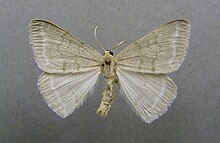| Grass emerald | |
|---|---|

| |

| |
| Scientific classification | |
| Domain: | Eukaryota |
| Kingdom: | Animalia |
| Phylum: | Arthropoda |
| Class: | Insecta |
| Order: | Lepidoptera |
| Family: | Geometridae |
| Genus: | Pseudoterpna |
| Species: | P. pruinata
|
| Binomial name | |
| Pseudoterpna pruinata | |
| Synonyms | |
| |
The grass emerald (Pseudoterpna pruinata) is a species of moth. It occurs throughout central and south-eastern Europe (with the exception of the far north) and in Asia Minor and the Caucasus further east to the Urals and Siberia. It is fairly common throughout Great Britain with the exception of northern Scotland. In the southern Alps, it rises up to 1500 metres. The species was first described by Johann Siegfried Hufnagel in 1767.
- ^ Pitkin, Linda M.; Han, Hongxiang; James, Shayleen (June 11, 2007). "Moths of the tribe Pseudoterpnini (Geometridae: Geometrinae): a review of the genera" (PDF). Zoological Journal of the Linnean Society. 150 (2): 334–412. doi:10.1111/j.1096-3642.2007.00287.x. Archived from the original on April 25, 2012.
{{cite journal}}: CS1 maint: unfit URL (link)